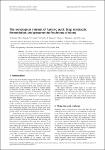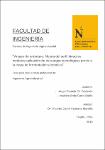The oenological interest of fumaric acid: Stop malolactic fermentation and preserve the freshness of wines

View/
Descargar
(application/pdf: 304.0Kb)
(application/pdf: 304.0Kb)
Date
2019-10-23Author(s)
Morata, A.
Bañuelos, M.A.
López, C.
Chenli, S.
Vejarano, R.
Loira, I.
Palomero, F.
Suárez- Lepe, J.A.
Metadata
Show full item recordAbstract
ABSTRACT
One of the problems related to the increase in average temperatures in the wine-growing regions is the lower accumulation of organic acids in the berries. Wine freshness depends to a great extent on its acidity. Herein, the effectiveness of fumaric acid to inhibit malolactic fermentation or to stop it once initiated is evaluated in order to preserve the malic acid content. Different doses of fumaric acid and SO2 were tested. The ability of these compounds to inhibit bacterial development and stop the malic acid degradation was testedonaredwineofthevarietyVitisviniferaL.cv.Tempranillowhosemalicacidcontentwassetat1.5g/L. The control wine inoculated with 6 log CFU/mL of Oenococcus oeni finished the malolactic fermentation in 12 days. However, the use of doses equal to or greater than 300mg/L of fumaric acid delayed the onset of malolactic fermentation for more than 50 days with little degradation of malic acid. In addition, fumaric acid proved to be effective in stopping malolactic fermentation already started where the bacterial count was 7 log CFU/mL. Fumaric acid can be considered as a potent inhibitor of malolactic fermentation.
Mostrar más
Bibliographic citation
Morata, A. ...[et al]. (2019). The oenological interest of fumaric acid: Stop malolactic fermentation and preserve the freshness of wines. BIO Web of Conferences, 15(2034). https://doi.org/10.1051/bioconf/20191502034
Collections
The following license files are associated with this item:
Related items
Showing items related by title, author, creator and subject.
-
Use of fumaric acid to control pH and inhibit malolactic fermentation in wines
Morata, Antonio; Bañuelos, María Antonia; López, Carmen; Song, Chenli; Vejarano, R.; Loira, Iris; Palomero, Felipe; Suarez-Lepe, José Antonio (Taylor & Francis, 2019-11-07)Acceso abiertoABSTRACT Fumaric acid is an additive allowed by the Codex Alimentarius and under evaluation by the International Organisation of Vine and Wine (OIV) that can be used for wine acidification but also to inhibit malolactic ... -
Saccharomycodes ludwigii, control and potential uses in winemaking processes
Vejarano, Ricardo (MDPI, 2018-08-28)Acceso abiertoNon-Saccharomyces yeasts are becoming important because most of them are considered as spoilage species in winemaking processes, among them the species Saccharomycodes ludwigii. This species is frequently isolated at the ... -
Vinagre de arándano: mejora del perfil bioactivo mediante aplicación de estrategias tecnológicas previo a la etapa de fermentación alcohólica
Gil Calderón, Angie Pamela; Cano Otañe, Maickol Andy (Universidad Privada del Norte, 2019-10-28)Acceso abiertoEl consumo de alimentos ricos en antocianos como el arándano (Vaccinium corymbosum), puede ayudar a prevenir diversas enfermedades debido a su capacidad antioxidante y antiinflamatoria. Al ser un producto perecedero y ...





